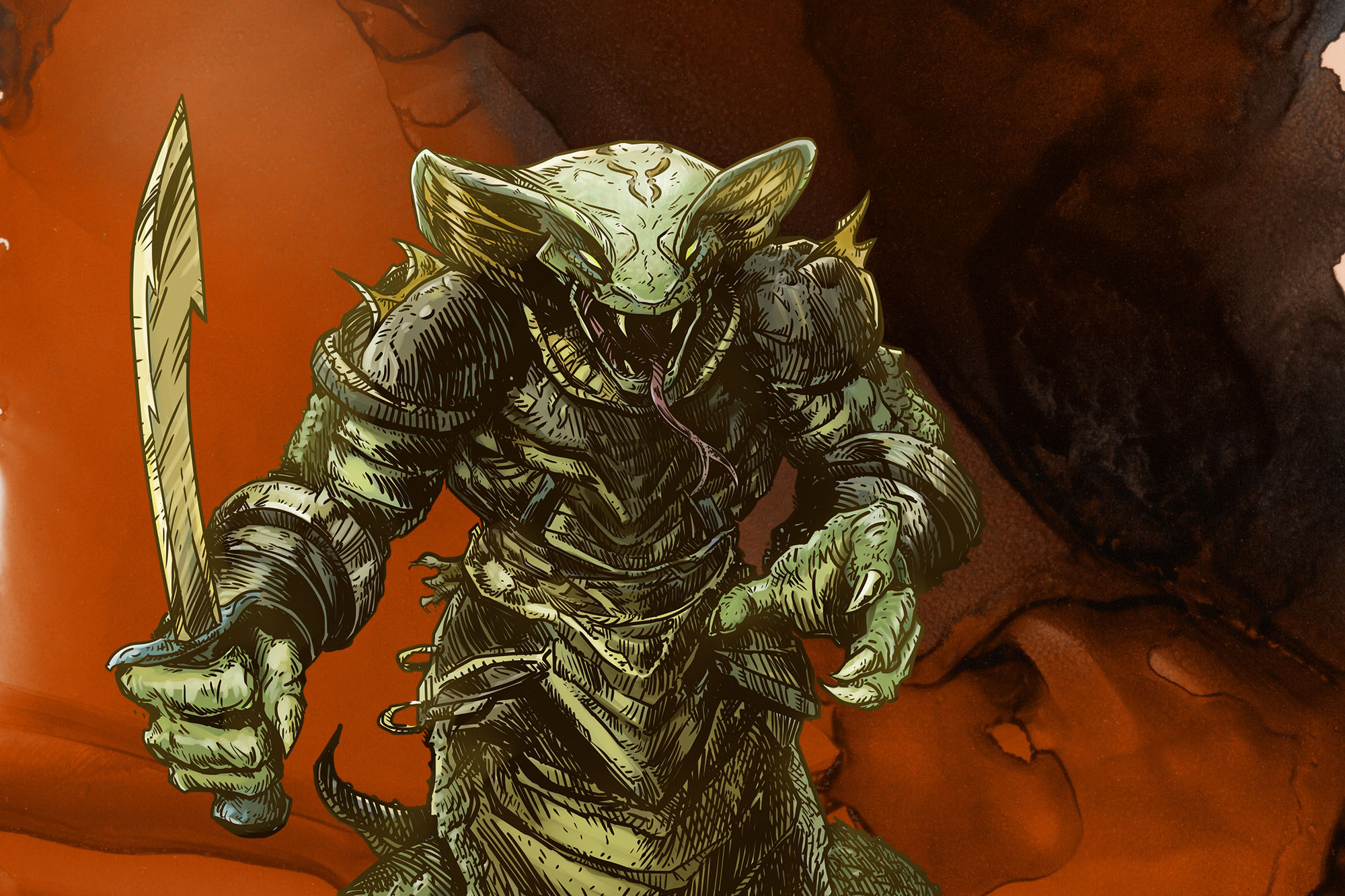Bruce Cordell gives us a solid adventure, but ultimately fails to excite us.
Review Originally Published March 15th, 2002
Wizard’s Adventure Path modules are designed to take a group of starting adventurers from 1st level all the way to 20th. (You can read my reviews of The Sunless Citadel, The Forge of Fury, The Speaker in Dreams, and The Standing Stone here on RPGNet the Alexandrian.)
The first two modules in this series — The Sunless Citadel and The Forge of Fury — are, in my opinion, destined to become classics. These modules succeeded on three levels: First, they were executed with near-flawless precision. Second, they embodied two ineffable archetypes of D&D (a dungeon and a dwarven citadel). Finally, while playing with archetypal structures they also avoided the cliché by offering a few unique twists, lots of specific color, and well-designed encounters and scenarios.
The next two adventures in the series, unfortunately, tapered off somewhat: The Speaker in Dreams is well-executed, but simply lacks a certain degree of flair. Where The Sunless Citadel and The Forge of Fury have the potential to generate stories that will be swapped around your gaming table for years to come, The Speaker in Dreams provides only a light weekend’s entertainment. The fourth module, The Standing Stone, proceeded to drop the ball entirely – bordering on the unplayable without serious fix-up work by the DM.
Which brings us to the fifth Adventure Path module, Heart of Nightfang Spire, designed for 10th-level PCs.
PLOT
Warning: This review will contain spoilers for Heart of Nightfang Spire and The Sunless Citadel. Players who may find themselves playing in this adventure should not read beyond this point.
Heart of Nightfang Spire is something of a sequel to The Sunless Citadel, although there’s absolutely no requirement that the party has played through the previous module. (And I mean that: This isn’t one of those “you don’t need the previous module; but this one is going to suck if you don’t have it”. Heart of Nightfang Spire really does stand by itself.) At the end of The Sunless Citadel, the players cut down the evil Gulthias Tree, which had grown from the stake stabbed through the heart of a vampire.
Unfortunately, the vampire – Gulthias – wasn’t actually dead when the PCs did this, just impaled. As a result, shortly after the PCs left, Gulthias rose once more, returning to this old power base, Nightfang Spire.
(Play the ominous music here.)
Basically it breaks down like this: Gulthias is the leader of a cult of undead, all of whom worship the dragon Ashardalon. Although Ashardalon was killed centuries ago (in fact, the titular heart of Nightfang Spire is Ashardalon’s heart, transformed into a powerful evil artifact), Gulthias believes that if he performs enough atrocities in Ashardalon’s name, the dragon will return. Gulthias is probably insane.
The PCs head off to Nightfang Spire. Once there, they have to fight through undead, girallons, and a couple of demonic servitors in order to collect the four parts of the dragon key which give them access to the Spire’s core, where they face off against Gulthias and (presumably) destroy the evil heart.
(Roll credits.)
WEAKNESSES
Overall, Heart of Nightfang Spire represents an improvement over both The Standing Stone and The Speaker in Dreams. Unfortunately, it also fails to get back up to the high quality of The Sunless Citadel and The Forge of Fury.
Ultimately, here, the flaw is not one of execution: With only a couple of exceptions, Heart of Nightfang Spire is flawless. The problem lies in Cordell’s failure to actively excite you with his adventure: Nightfang Spire is simply not all that interesting as a location; Gulthias’ cult simply isn’t that interesting an antagonist.
I mean, let’s take a closer look at the cult: As far as I can tell, their master plan boils down to nothing more than “being really nasty”. There’s nothing wrong with that, but are you really going to turn to one of your gamer buddies in later years and say, “Hey, you remember that time we beat those guys who were being really nasty?”
Similarly, there’s nothing wrong about Nightfang Spire, but there’s also nothing special about it: It’s a tower with some catacombs underneath it.
And the problem here isn’t that you won’t be swapping stories about Nightfang Spire five years from: It’s that Nightfang Spire is boring. Because there’s nothing unique about the setting, and because there’s really nothing memorable about the villains, Heart of Nightfang Spire plays like the worst of all possible dungeon crawls: Kick open the door. Kill the monsters. Gather the treasure. Rinse. Lather. Repeat.
A couple of other minor flaws I want to mention here:
First, the text of the module does not match the interior illustration which does not match the map which does not match the cover. In short, there are about a half dozen versions of the Spire in this product.
Second, the Adventure Path series as a whole suffers from very weak adventure hooks (as I’ve commented in my previous reviews). Heart of Nightfang Spire is no exception. (And this helps contribute to the lack of any sense of purpose in the module.)
Finally, Cordell doesn’t use his villains to their full effectiveness. For example, Gulthias has inscribed a magical rune in various locations throughout the Spire – allowing him to scry on those locations and teleport his vampiric spawn through the runes to those locations. But, despite a few lackluster notes about potential courses of action Gulthias might take, these gazeways (as they are called) are never truly used to their full potential. I want to see vampiric hit squads teleported in behind the PCs; hit-and-run tactics that the PCs can’t figure out; and so forth. Once Gulthias knows the PCs are there I want to see him mobilize the entire tower, not sit sulking in his lair waiting for the PCs to systematically wipe him out.
STRENGTHS
I’ve explained to you everything that’s wrong with Heart of Nightfang Spire. Now let me show you that I’ve been a little unfair:
First, there is some unique flair to Nightfang Spire. Specifically, the adventure is designed so that the PCs have to fly through the top of the tower and then work their way down. Unfortunately, this is complicated somewhat by area 1 – which is some sort of ground level entrance to the tower. Although the description of area 1 suggests that there is still a door providing access to the tower here, this door remains completely unreferenced on the maps. I can only conclude that, in point of fact, this entrance does not exist (possibly it was bricked up at some point in the past?).
Second, there are some encounters here which are notably well done. For example, the 7th-level monk mummy and the vampiric gibbering mouther. Both of these technically violate the rules, but it doesn’t really matter: They’re cool concepts. Also, the module opens with a mid-air fight as the PCs try to gain access to the Spire – an encounter which is probably the highlight of the adventure (which is unfortunate, because it’s also the first encounter of the adventure – it’s all down hill from here).
Third, Cordell does present an environment where creatures respond to disturbances near them. In fact, on a room-by-room level, the Spire is far more detailed in terms of dynamic monster reactions than most modules. The problem is that the Spire, by its very nature, should be even more dynamic.
Finally, let me repeat myself by saying that Heart of Nightfang Spire is a solid adventure. The execution of the actual elements is almost impeccably solid: It’s only the elements themselves which lack a certain luster to my eyes.
CONCLUSION
Ultimately, as I step back and look at Heart of Nightfang Spire, I am struck by a single word:
Bland.
That being said, there’s enough raw material here that you should be able to spice things up easily enough: First, give the cult some meat. They need a real, tangible, meaningful, threatening goal. Wiping out a pocket of random evil is about as exciting as watching paint dry, but having tale to tell about stopping the Cult of Gulthias from [insert dramatic plot here]? That has something going for it. (This may be as simple as having the return of Ashardalon as a serious, tangible threat – rather than something so utterly ridiculous that people giggle about it behind Gulthias’ back.)
Second, really work on giving the tower a credible defense. Gulthias not only becomes a more memorable villain if he’s manipulating his minions (and using his own powerful abilities) to constantly harass the PCs, but the entire adventure will become far more exciting because – in one stroke – you will have successfully demolished the “kick open door, kill monsters, gather treasure” mentality which is here right now. (Two things to watch for here: First, the girallons are already very potent opponents. If you allow Gulthias to gang them up against the PCs, the PCs will most likely be dead. By the same token, the PCs should really need to retreat and regroup if Gulthias manages to get his defenses credibly focused. Second, once Gulthias knows the PCs are going for the dragon key he isn’t going to just sit there and let them gather the pieces together so that they can come and destroy him.)
So, in the final analysis, Heart of Nightfang Spire is probably a good value for your money. But I would recommend against running it straight out of the box: The result will likely disappoint.
Style: 4
Substance: 4
Authors: Bruce Cordell
Company: Wizards of the Coast
Line: D&D
Price: $9.95
ISBN: 0-7869-1847-0
Production Code: WTC11847
Pages: 32
When I ran The Sunless Citadel, I revamped the entire mythology behind the Gulthias Tree. In doing so, I’d inadvertently cut myself off from using Heart of Nightfang Spire, which is, obviously, completely dependent on the original mythology of the staked vampire. (The concept of the PCs accidentally freeing a staked vampire is very clever, though.) As a result, I’ve never actually run Heart of Nightfang Spire.
I think my closing paragraphs, however, were groping towards a desire to remix these Adventure Path modules in a way that would perhaps bind them just a little closer together: The opportunity to learn more lore about Ashardalon throughout the series, for example. Or for Gulthias’ resurgent cult to have more connections to and lore about the wider drama.
I should probably resist the temptation to go deeper down this rabbit hole…
For an explanation of where these reviews came from and why you can no longer find them at RPGNet, click here.

















